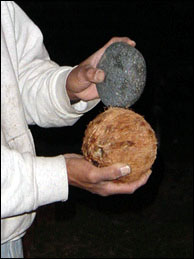
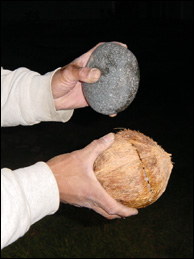


The stone is banged along the coconut's middle or greatest diameter. This causes a crack to form that will encircle the coconut shell. Rotate the coconut as you whack around the shell.
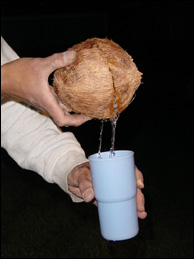
As the crack becomes wider, place a cup under the shell to catch the coconut water. If the coconut is not too old, the refreshing liquid can be quite sweet and delicious.
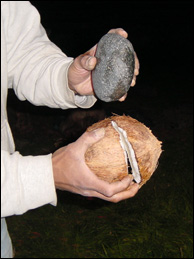
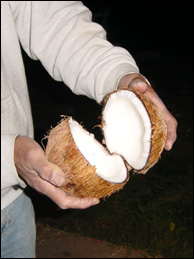
When you have drained out all the water, continue cracking the coconut shell with the rock until it opens.
The coconut produced different food resources as the nut matured. The various stages of the development of the nut with the condition of the flesh ('i'oniu) are given by Craighill Handy (The Hawaiian Planter - Volume I, 1940, pg. 191) as follows:
'o'io: jelly-like flesh
haohao: soft white flesh, shell still white
'ili 'ole: flesh of half-ripe nut
niu o'o: flesh mature, husk not dried
niu malo'o: flesh mature, husk dry, fluid present
niu 'aka'a: old nut, no water, flesh separates easily
As noted by Te Rangi Hiroa (Arts and Crafts of Hawaii, Section I, Food, 1957, pg. 8): "The 'ili 'ole was the stage preferred for eating raw with mashed taro (poi), the niu malo'o, for making coconut cream; and the niu aka'a, for making coconut oil."
In Old Hawai'i, the coconut, or niu, was not utilized for food to the same extent it was used in other south Pacific cultures. Today, the coconut flesh is used in a variety of Hawaiian recipes. One of the food that was made from grated coconut and mashed sweet potatoes was called piele. Coconut cream was sometimes substituted for the grated coconut. The coconut cream was squeezed from the flesh of the grated mature nut to produce the milky fluid.
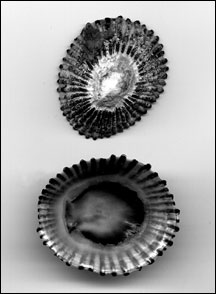
To grate the coconut flesh, a limpet ('opihi) shell from the seashore was an ideal tool. The serrated edges of the shell shredded the white meat very easily.
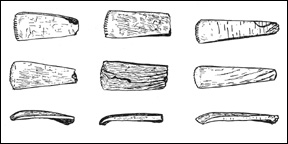
Also, large Conus shells were cut and formed into grating implements with a serrated end. The coconut shredders in the illustration above are from the Bishop Museum in Honolulu, Hawai'i.
If you want to use contemporary kitchen tools, a butter knife and a cheese grater will suffice. Slice a small, pie shaped piece on the coconut meat with the butter knife. Pry apart the cut section of the meat using the tip of the butter knife. This should pop out the pie shaped meat as a starting point. Slice another small, pie shaped meat and pop that section out. Continue the same process until you have removed all of the coconut meat from the shell. Then, grate the pieces of coconut flesh with the cheese grater.
The sweet potatoes are cooked and the skins are removed. The potatoes are mashed in a container with the fingers and some water is added. The grated coconut flesh (or coconut cream) is then added to the sweet potato mixture. Traditionally, the piele was bundled in ti leaves and cooked in an earth oven. You can wrap your piele in aluminum foil and bake it in your kitchen oven at 300 degrees Fahrenheit for 30 to 45 minutes.
Enjoy a taste of Hawaiian cuisine using niu!
E-mail your comments to "Dino Labiste" at KahikoArts@yahoo.com
We hope the information on the PrimitiveWays website is both instructional and enjoyable. Understand that no warranty or guarantee is included. We expect adults to act responsibly and children to be supervised by a responsible adult. If you use the information on this site to create your own projects or if you try techniques described on PrimitiveWays, behave in accordance with applicable laws, and think about the sustainability of natural resources. Using tools or techniques described on PrimitiveWays can be dangerous with exposure to heavy, sharp or pointed objects, fire, stone tools and hazards present in outdoor settings. Without proper care and caution, or if done incorrectly, there is a risk of property damage, personal injury or even death. So, be advised: Anyone using any information provided on the PrimitiveWays website assumes responsibility for using proper care and caution to protect property, the life, health and safety of himself or herself and all others. He or she expressly assumes all risk of harm or damage to all persons or property proximately caused by the use of this information.
© PrimitiveWays 2013